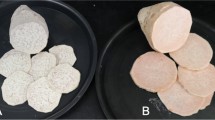Abstract
The neglect of traditional processing methods in the production of gari (toasted cassava granules) has been blamed for reported cases of poisoning following consumption of gari. This study investigatedthe nutritional and clinicopathologic effects of not enriching cassavamash with red palm oil (RPO) during gari production. Two garisamples were produced with and without RPO. Total cyanogen, acetonecyanohydrin, free cyanogen and crude protein contents were not found tobe significantly (p>0.05) different between the two. The samples werefed exclusively to two different groups of Sprague-Dawley rats for a tenweek experimental period during which clinical observations were recordeddaily. At the end, vital body organs were examined grossly and microscopically. There was a significant (p<0.05) reduction in severityand percentage of animals exhibiting clinical abnormalities and lesions ofchronic cyanide poisoning in the group fed gari produced with RPO.This result implies an association between the enrichment of cassava mashwith RPO during gari production and the reduction of severity andpercentage of animals affected by chronic cyanide poisoning.
Similar content being viewed by others
References
Phillips TP (1983) An overview of cassava consumption. In Delange F, Ahluwalia R (eds), Cassava Toxicity and Thyroid-Research and Public Health Issues. IDRC-207e, IDRC Canada, pp 83-88.
Nweke FI (1996) Cassava processing in sub-saharan Africa – Implications for expanding cassava production. IITA Research 12: 7–13.
Bokanga M (1996) Biotechnology and cassava processing in Africa. IITA Research 12:14–18.
Oke OL (1968) Cassava as food in Nigeria. World Rev Nutr Diets 9: 227–250.
Silano V, Banzul HC, Bozzini A (1982) Improvement of nutritional quality of food crops-A state of the art report. In FAO Plant Production and Protection Paper No. 34. Rome: FAO of the United Nations, pp 15-36.
Oke OL (1994) Eliminating cyanogens from cassava through processing-Technology and tradition. Cassava Safety, Acata Horticulturae 375: 163–174.
Hahn SK (1997) Traditional processing and utilization of cassava in Africa. IITA Research Guide 41: 6–25.
Bourdoux P (1980) Antithyroid action of cassava in humans. In Ermans AM, Mbulamoko NM, Delange F, Ahluwalia R (eds), Role of Cassava in the Aetiology of Endemic Goitre and Cretinism. IDR Canada: IDRC-136e, pp 36-44.
Ermans AM, Bourdoux P, Kinthaert J, Lagasse R, Luvilak K, Matuta M, Thilly CH, Delange F (1983) Role of cassava in the aetiology of endemic goitre and cretinism. In Delange F, Ahluwalia R (eds), Cassava Toxicity and Throid-Research and Public Health Issues. IDRC, Canada: IDRC-270e, pp 9–16.
Delange F, Ekpechi LO, Rosling H (1994) Cassava cyanogenesis and iodine deficiency disorders. Cassava Safety, Acta Horticulturae 375: 289–293.
Howlett WP (1994) Konzo-A new disease entity. Cassava Safety, Acta Horticulturae 375: 323–329.
Tylleskar T (1994) The association between cassava and the paralytic disease konzo. Cassava Safety, Acta Horticulturae 375: 331–339.
Akintonwa A, Tunwashe OL (1992) Fatal cyanide poisoning from Cassava based meal. Human Exp Toxicol 11: 47–49.
Nweke FI (1994) Processing potential for cassava growth in Africa. In Colloborative Study of Cassava in Africa (COSCA) Working Paper No. 11, COSCA Ibadan, Nigeria: pp 7–11.
Akintonwa A, Tunwashe O, Onifade A (1994) Fatal and non-fatal acute poisoning attributed to cassava based meals. Cassava Safety, Acta Horticulturae 375: 285–288.
Oyenuga VA (1968) Nigerias Foods and Feeding Stuffs-Their Chemistry and Nutritive Value. Nigeria: Ibadan University Press, pp 75–79.
Ononogbu IC (1988) Lipids and Lipoproteins-Chemistry, Methodology, Metabolism, Biochemical and Physiological Importance. Nigeria: New Africa Publishing Co. Ltd., pp 45–58.
Hartley CWA (1967) The Poil Palm (Elaeis guineensis Jacq). Longmans, Green & Co. Ltd.
Ong ASH, Tee ES (1992) Natural sources of carotenoids from plants and oils. Method in Enzymology 213: 142–167.
AOAC (1990) Official Methods of Analysis of the Association of Official Analytical Chemists. 15th ed. AOAC, Arlington, Virginia USA.
Egan SV, Yeoh HH, Bradbury JH (1997) Simple picrate paper kit for determination of the cyanogenic potential of cassava flour. J Sci Food Agric 75: 258–262.
Arua AI, Okafor FC (1997) Fundamentals of Statistics for Higher Education. Nigeria: Fijac Academic Press.
Ihedioha JI, Cheneme CN (1999) Effect of varied fermentation periods on the diabetogenic potential of toasted cassava granules. Plant Foods Hum Nutr 53: 159–168.
Kamalu BP (1989) Experimental Cyanide Toxicosis in Growing Male Dogs on Nutritionally Balanced Diets-Clinical Chemistry and Histopathology. Master of Science Thesis, Nsukka: Dept. of Veterinary Pathology and Microbiology, University of Nigeria.
Robbins SL (1970) Pathologic Basis of Disease. Philadelphia: W.B. Saunders, Co.
Ononogbu IC (1980) The toxicity of cassava. Trends Biochem Sci Sept 1980: x–xi.
Cliff J, Lundquist P, Martensson J, Rosling H, Sorbo B (1985) Association of high cyanide and low sulfur intake in cassava-induced spastic paraparesis. Lancet ii: 1211–1213.
Angeli-Greaves M, McLean AEM (1979) The effect of diet on the toxicity of drugs. In Gorrod JW (ed), Drug Toxicity. London: Taylor and Francis Ltd., pp 91–100.
Osuntokun BO (1994) Chronic cyanide intoxication of dietary origin and a degenerative neuropathy in Nigerians. Cassava Safety, Acta Horticulturae 375: 311–321.
Smith HA, Jones TC, Hunt RC (1972) Veterinary Pathology. Philadelphia: Lea and Febiger, pp 34–53.
Author information
Authors and Affiliations
Rights and permissions
About this article
Cite this article
Ihedioha, J. The clinicopathologic significance of enriching grated cassava mash with red palm oil in the production of gari . Plant Foods Hum Nutr 57, 295–305 (2002). https://doi.org/10.1023/A:1021824031799
Issue Date:
DOI: https://doi.org/10.1023/A:1021824031799




